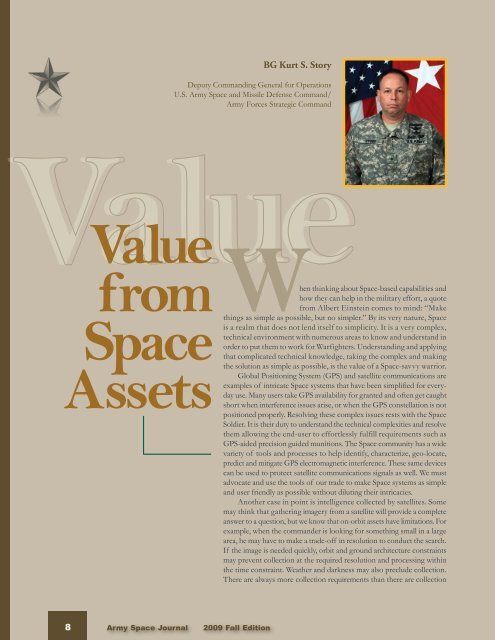Volume 8, Number 3 - Space and Missile Defense Command - U.S. ...
Volume 8, Number 3 - Space and Missile Defense Command - U.S. ...
Volume 8, Number 3 - Space and Missile Defense Command - U.S. ...
Create successful ePaper yourself
Turn your PDF publications into a flip-book with our unique Google optimized e-Paper software.
BG Kurt S. Story<br />
Deputy Comm<strong>and</strong>ing General for Operations<br />
U.S. Army <strong>Space</strong> <strong>and</strong> <strong>Missile</strong> <strong>Defense</strong> Comm<strong>and</strong>/<br />
Army Forces Strategic Comm<strong>and</strong><br />
Value<br />
from<br />
<strong>Space</strong><br />
Assets<br />
When thinking about <strong>Space</strong>-based capabilities <strong>and</strong><br />
how they can help in the military effort, a quote<br />
from Albert Einstein comes to mind: “Make<br />
things as simple as possible, but no simpler.” By its very nature, <strong>Space</strong><br />
is a realm that does not lend itself to simplicity. It is a very complex,<br />
technical environment with numerous areas to know <strong>and</strong> underst<strong>and</strong> in<br />
order to put them to work for Warfighters. Underst<strong>and</strong>ing <strong>and</strong> applying<br />
that complicated technical knowledge, taking the complex <strong>and</strong> making<br />
the solution as simple as possible, is the value of a <strong>Space</strong>-savvy warrior.<br />
Global Positioning System (GPS) <strong>and</strong> satellite communications are<br />
examples of intricate <strong>Space</strong> systems that have been simplified for everyday<br />
use. Many users take GPS availability for granted <strong>and</strong> often get caught<br />
short when interference issues arise, or when the GPS constellation is not<br />
positioned properly. Resolving these complex issues rests with the <strong>Space</strong><br />
Soldier. It is their duty to underst<strong>and</strong> the technical complexities <strong>and</strong> resolve<br />
them allowing the end-user to effortlessly fulfill requirements such as<br />
GPS-aided precision guided munitions. The <strong>Space</strong> community has a wide<br />
variety of tools <strong>and</strong> processes to help identify, characterize, geo-locate,<br />
predict <strong>and</strong> mitigate GPS electromagnetic interference. These same devices<br />
can be used to protect satellite communications signals as well. We must<br />
advocate <strong>and</strong> use the tools of our trade to make <strong>Space</strong> systems as simple<br />
<strong>and</strong> user friendly as possible without diluting their intricacies.<br />
Another case in point is intelligence collected by satellites. Some<br />
may think that gathering imagery from a satellite will provide a complete<br />
answer to a question, but we know that on-orbit assets have limitations. For<br />
example, when the comm<strong>and</strong>er is looking for something small in a large<br />
area, he may have to make a trade-off in resolution to conduct the search.<br />
If the image is needed quickly, orbit <strong>and</strong> ground architecture constraints<br />
may prevent collection at the required resolution <strong>and</strong> processing within<br />
the time constraint. Weather <strong>and</strong> darkness may also preclude collection.<br />
There are always more collection requirements than there are collection<br />
8<br />
Army <strong>Space</strong> Journal<br />
2009 Fall Edition
















